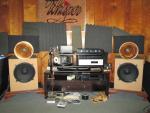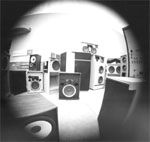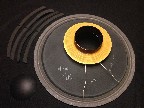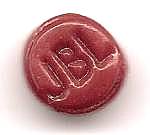Hi gang,
Quite a discovery tonight. I was patent surfing as I do occasionally- reading U.S. Patents related to speakers, following cited references to earlier patents and printing out the juicy ones. This can easily go on for hours and drain printer cartridges.
Anyway, I happened on to a very surprising U.S. Patent issued to G.L. Carrington, long time president of Altec Lansing from the formation of the company in 1941 onward. It describes the speaker that Altec produced beginning about 1946 as the 603 Dia-cone; a 15" full range driver that used a 3" aluminum center dome loaded by a multicellular horn- essentially the same horn that was used in the 604 Duplex. It is U.S. Patent #2,568,883, "Loud-Speaker with Expanding Horn Unit."
The funny thing is that an article introducing the 603 Dia-cone was written by John Hilliard and published in the May, 1947 issue of Audio Engineering magazine ("High Fidelity Loudspeaker of Unique Design"). I had always assumed that the 603 was largely Hilliard's work, likely assisted by Jim Lansing before he left Altec in mid 1946. I am fortunate to own 603 #15, mounted on its original baffle board complete with the authentic-looking initials "JBL" in pencil. Now, kaboom, we find a patent on the design issued to Carrington!
I have always regarded George Carrington Sr. as a management "suit", a competent corporate cheiftain from the old ERPI heirarchy who came to lead Altec after their purchase of Lansing Manufacturing Company. Todd White of the Unofficial Altec Lansing web site has attempted to give credit to Carrington for loudspeaker engineering in our past sparring on the Audio Asylum, and I scoffed at this. It is now looking like some crow pie might be on the menu for me!
The patent can be viewed or printed out at:
http://www.pat2pdf.org/patents/pat2568883.pdf
One thing that has fascinated me ever since this web site was conceived is that the pieces of the history puzzle keep falling into place, bit by bit, seemingly at their own pace. The principals are nearly all dead now, yet useful information continues to surface regularly either in correspondence, in ebay auctions, or in happy accidental discoveries such as this one. Damn, this is fun!




 Reply With Quote
Reply With Quote







